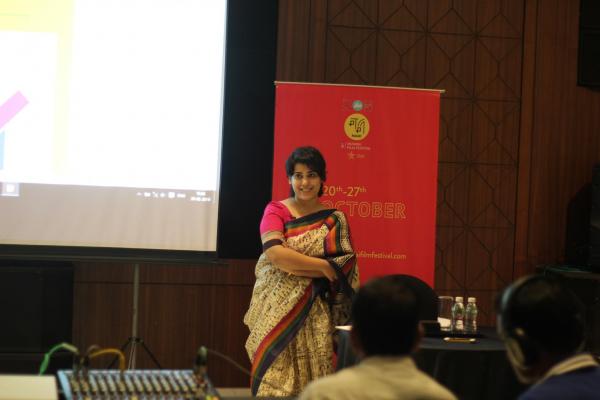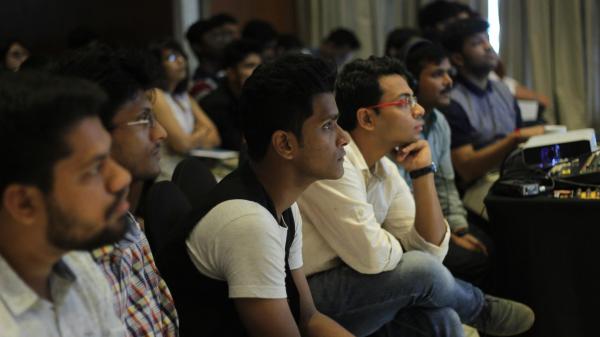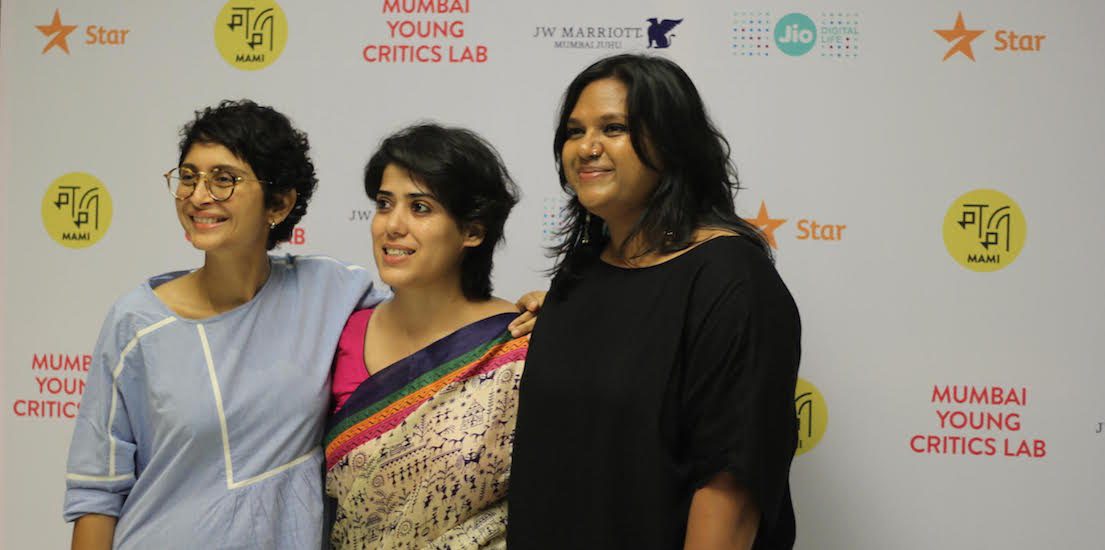MAMI Young Critics Lab – Honing the art of ‘critiquing’
A cameraman’s urge
Akshay Nair, a photographer and director sits in a ballroom in J W Marriott, Juhu (Mumbai). It is a break and everyone is busy talking about three act structure over the three course lunch. Akshay has other plans. He is flipping through the freshly clicked images. He is being his own critic. The space in question is the two-day Young Critics Lab conducted by Jio MAMI Mumbai Film Festival with Star on August 20 and 21. The event is headed by Film Scholar and Journalist Deepanjana Pal. Akshay has been called to take stills.
I bumped into Akshay and asked him what did this lab mean to him as he too was a participant but with a different responsibility at hand. Akshay asserted, “For me it’s like hitting two birds with one stone. I am getting to attend the lecture and at the same time, getting paid for it. (Laughs) I am learning a lot here. The clips that are being shown are from the films that I have already seen. But here, additionally, I am getting to hear different perspectives on the same clips. This is a big learning. Deepanjana showed clips from The White Ribbon (A Michael Haneke film) and asked the participants questions like ‘who shot the film?’. I know answers to those questions but technically I am not in a position to answer. I am controlling my urge. This is one of my dream workshops!”
READ: JIO MAMI WITH STAR CAMPAIGN FILM 2016

Deepanjana Pal during the session
A curator’s homework
I left Akshay with his solitude and decided to speak with Deepanjana. It was a running lunch for her. What was the brief given to you by team MAMI, I asked?
“I was told that they are a bunch of college students who are interested in films. Of these, a certain number will be shortlisted to write for the festival bulletin at the time of the festival in October. So, I was supposed to conduct a workshop where they pick up on certain aspects of film appreciation. Obviously, this isn’t a course like one would have in a college. So, we can’t dwell into that kind of detail. But yes, as a basic course these students will be exposed to essential elements that you need to keep in mind while writing about cinema.”
On being asked about her homework for the workshop she added, “The idea is very simple. This is an introduction to both commercial cinema and non-commercial cinema. The reason for this is that both are important. It is extremely important to know non-commercial cinema because that is what the festival is about. It’s also in many ways the kind of cinema that informs sensibilities. This cinema isn’t popular, but, in a way, it forms a yardstick of what is considered excellence in films. But having said that, popular cinema is extremely important for the very fact that it’s popular. One feeds the other more so today than ever before. These are no more fixed genres as they used to be 2-3 decades back. So, the idea behind the workshop is just that. Now, if I am discussing Michael Haneke’s ‘The White Ribbon’ then I am also discussing something as mainstream and popular as Zack Snyder’s ‘The Watchmen’. I plan to discuss ‘mood’ by showing some of the works of Wong Kar Wai. More than the films, I focus on the craft itself. So, I chose auteurs. They are symptomatic to the genres they belong to. While Zack on one hand is out-and-out Hollywood, Wong Kar Wai doesn’t essentially rely on a narrative. Once we are through with this we will move to politics of films and filmmaking. It’s all very introductory, accessible and interactive. For the first day we will be talking about film structure, commercial and non-commercial cinema, narrative and perspective. Formalism, Realism, and different critical approaches that one takes will be discussed in the remaining part of the lab.”
Out of the total of participants, which is over sixty, twenty will be selected for writing for the festival. After the festival gets over there will be awards given to the Best Young Critic and a runners-up for the same. These students have been handpicked from media colleges from different parts of Mumbai. The participants were nominated from their respective colleges.
Talking about the selection procedure for the next round Pal added, “The first assignment is writing a five-hundred-word piece on one figure (Either from Hollywood or Bollywood), which they feel is important and about his/her contribution to cinema. It is an open book exam and they are free to consult the internet. For the second assignment I will be showing them the first 15 minutes of Satyajit Ray’s ‘Charulata’ and Shyam Benegal’s ‘Bhumika’ and will be asking them to do a comparison of portrayal of woman in both the films. They are both trapped women shown in very different ways.”
A Chairperson’s vision
Also present at the event was Kiran Rao, Chairperson, MAMI, who was enthusiastically attending the session. In a previous talk with her during Brahman Naman’s screening she had promised that MAMI will focus on building a year-round interaction with the cinephiles of the city. This truly looked like one such effort.
When being asked about her experience with the ongoing session she asserted, “This is the first time that I am attending it. Unfortunately, I could not attend it last year when Meenakshi Shedde was conducting. This time, it is divided in three steps. In the first step Deepanjana will mentor all the participants and select twenty students for the second round which will happen in September. In the final round we will have Nick James leading with Deepanjana’s support. It is a rich conversation on cinema. To be a critic does not mean just writing a review of the film. It has a lot of other components backing it. A lot of it is semantic and semiotic. It means, to be able to hone your eyes and other skills such as reading. A lot also depends on your own apperceptive background.”
“I was listening to her (Deepanjana) speak and the session had come to a point where a conclusion has been reached that none of us can be objective. There is no such thing as objectivity. While writing we all have our biases. It is more about going beyond the images that you see. So, it’s not directly about how to write a review. It’s to build a critic who has a skill set to look at the film beyond the weekly review,” concludes Rao.
READ: MAMI FILM CLUB – A YEAR ROUND CELEBRATION OF CINEMA
The dreamers – Then and now

Participants of MAMI Young Critics Lab during the session
On this note I decided to sit in the lecture. Sitting right next to me was Yash Raj, a student of Tilak College, Navi Mumbai. Yash asked me if I was a film journalist. I said yes and introduced myself. After this small talk, I started looking at the projection where the famous climax scene of ‘Jaane Bhi Do Yaaron‘ was playing. While I was giggling watching at the mavericks perform, a part of me thought about Yash, who clearly had a nose for news. I thought about his bright future as he jotted in his notebook. Who knows, in the coming years I could be reading his thoughts on films. All I hope is that this new generation of young critics does away with the popular star rating system of films used for cinema these days. Which to me is more appropriate to rate hotels than cinema!
MAMI Young Critics Lab – Honing the art of ‘critiquing’


